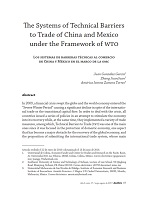The Systems of Technical Barriers to Trade of China and Mexico under the Framework of WTO
DOI:
https://doi.org/10.32870/mycp.v6i17.529Palabras clave:
TBT, México, China, WTO, Trade, Comercio, Economía.Resumen
In 2009, a financial crisis swept the globe and the world economy entered the “Severe Winter Period” causing a significant decline in spite of the international trade or the transitional capital flow. In order to deal with the crisis, all countries issued a series of policies in an attempt to stimulate the economy into its recovery while, at the same time, they implemented a variety of trade measures, among which, Technical Barriers to Trade (TBT) was one of the main ones since it was focused in the protection of domestic economy, one aspect that has become a major obstacle for the recovery of the global economy, and the proposition of submitting the international trade system, whose main contents include a multilateral trading system and the rules of WTO, to a severe test. China and Mexico are both emerging economies affected by other countries’ TBT measures, especially China, who became one of the main victims of the current round of trade protectionism. Taking base on the analysis of the current global TBT status and the regulations of the WTO, the research will compare similarities and differences of TBT systems between China and Mexico, making recommendations to both nations in order for them to cope with the trade protectionism impact currently prevailing in the world.Los sistemas de barreras técnicas al comercio de China y México en el marco de la OMCEn 2009, la crisis financiera azotó el mundo y la economía mundial entró en el “periodo de invierno severo” causando una caída significativa a pesar del comercio internacional o del flujo de capital transicional. Para hacer frente a la crisis, todos los países emitieron una serie de políticas para estimular la recuperación de la economía y, al mismo tiempo, implementaron una serie de medidas comerciales, entre las que se encuentran los barreras técnicas al comercio (BTC), siendo éstas de las principales, puesto que se centraron en la protección de la economía nacional, aspecto que se convirtió en un obstáculo importante para la recuperación de la economía global, y del envío de ésta al sistema del comercio internacional, cuyos principales contenidos incluyen al sistema de comercio multilateral y las reglas de la omc, sometiéndolos a una prueba severa. China y México son economías emergentes afectadas por las medidas BTC de otros países, especialmente China, que se convirtió en una de las principales víctimas de la actual ronda de proteccionismo comercial. Tomando como base el análisis de la actual situación mundial de btc y las re- gulaciones de la OMC, en la investigación se comparan similitudes y diferencias de los sistemas de btc entre China y México, haciendo recomendaciones a ambas naciones para que puedan hacer frente al impacto del proteccionismo comercial actualmente imperante en el mundo.Descargas
Citas
Dai, S. (1995). Mexico Federal Law of Standardization and Metrology. Shanghai Standardization, No. 2.
Du, H. (2013). The Challenge and Countermeasures of Trade Protectionism to wto [贸易保护主义对 wto 的挑战及其应对]. Retrieved from http://www.dylw.net/kuaijishenji/119887.html
Fan, J. (2005). Tbt Agreement and the Perfection of Chinese Standardization Law. Public Standardization, No. 11, pp. 11-14.
Li, H. (2005). Thoughts of Standardization Works. Enterprise Standardization, No. 12, pp. 28-30.
Linn, T. (2000). Antidumping in Mexico. Sweden: Lund University.
Ma, L. & Ren, L. (2005). On Perfection of Chinese Standardization Law. Public Standardization, No. 12, pp. 21-24.
Molina, V. I., García, F., Sepúlveda, D., Ávila, R., Jiménez, E., & Martínez, M. (2007). Outlook for the Development of Standards of Implementation of the emc in Mexico. National Meeting of Electrical Metrology.
Ni, Y. (2013). New Tendency of Trade Protection since Financial Crisis. Institute of Chinese World Economics and Politics.
Rodríguez, I. (2014). Interpretación de normas internacionales de distintos ordenamientos bajo el acuerdo de obstáculos técnicos al comercio de la omc. Boletín Mexicano de Derecho Comparado, No. 1, pp. 617-648. Retrieved from https://revistas.juridicas.unam.mx/index.php/derecho-comparado/article/view/4883/6234
World Trade Organization. (2008). Trade Policy Review. Report by Secretariat. Mexico: wt/tpr/s/195. Retrieved from http://www.jmcti.org/kaigai/Latin/2008/2008_03/2008_03_M01.pdf
World Trade Organization. (2013). Concluding remarks by Chairperson. Trade Policy Review
Mexico. Retrieved from http://www.wto.org/english/tratop_e/tpr_e/tp379_crc_e.htm
Yang, J. (2009). Comparative Research on Chinese Standardization Law and Russian Federal Technical Supervision Law. Study on Technical Management, No. 3, pp. 225-228.

Descargas
Publicado
Cómo citar
Número
Sección
Licencia
Política de acceso abierto
Esta revista proporciona un acceso abierto a su contenido, fiel al principio de que ofrecer al público un acceso libre a las investigaciones ayuda a un mayor intercambio global del conocimiento.
MyCP se publica bajo la licencia de Creative Commons Reconocimiento-No Comercial CC BY-NC
Los contenidos serán publicados en versión PDF y XML.
Los autores(as) que publiquen en México y la Cuenca del Pacífico aceptan las siguientes condiciones:
De acuerdo con la legislación de derechos de autor, México y la Cuenca del Pacífico reconoce y respeta el derecho moral de los autores(as), así como la titularidad del derecho patrimonial, mismo que será cedido a la Universidad de Guadalajara para su difusión en acceso abierto.
México y la Cuenca del Pacífico no realiza cargos a los autores(as) por enviar y procesar artículos para su publicación.
Los autores(as) pueden realizar otros acuerdos contractuales independientes y adicionales para la distribución no exclusiva de la versión del artículo publicado en México y la Cuenca del Pacífico (por ejemplo, incluirlo en un repositorio institucional o darlo a conocer en otros medios en papel o electrónicos) siempre que indique clara y explícitamente que el trabajo se publicó por primera vez en México y la Cuenca del Pacífico.
Una vez que se acepte el artículo para su publicación los autores(as) deben remitir el formato de carta-cesión de derechos de la publicación debidamente requisitado y firmado por los autores(as). Este formato debe ser remitido en archivo PDF paralelamente con la versión final del artículo al correo: mexicoylacuenca@gmail.com.
Los lectores/usuarios de México y la Cuenca del Pacífico pueden acceder directamente al contenido de manera libre y gratuita en todo momento, incluyendo cuando un nuevo número es colocado en la plataforma. Se permite al lector/usuario citar, compartir (electrónicamente y de manera física), imprimir y distribuir el material siempre que se indique de manera clara y explícitamente que el trabajo se publicó por primera vez en México y la Cuenca del Pacífico. Es necesario citar de manera correcta el trabajo y no debe de ser utilizado con fines comerciales.




